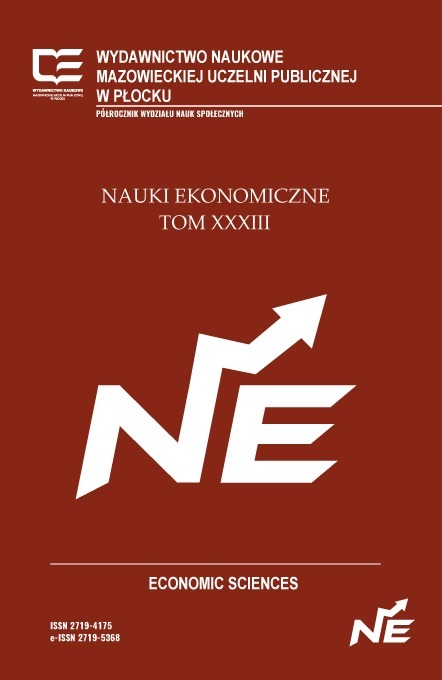EVOLUTION OF THE HELIX MODEL AS A DEVELOPMENT CONCEPT IN THE CONTEMPORARY WORLD ECONOMY
DOI:
https://doi.org/10.19251/ne/2021.33(6)Keywords:
helix model, development, innovation, knowledge, economy, regionAbstract
The purpose of this article is to analyze the conditions of the functioning of the helix model in a dynamic approach, as well as to synthetically present how changes in the development conditions of the modern world economy, including primarily technological changes as well as the processes of globalization, integration and regionalization as well as a qualitative subjective change, affect the evolution of the helix model and its application abilities. The main research hypothesis was formulated as follows: “The development concept based on a helix evolves towards the expansion of planes and groups of entities dynamising development processes and also increasing the quality of this development, mainly in the innovative plane.” The article uses the descriptive method and the methods of non-reactive research, especially the historical-comparative method, e.g. in order to present the differences in the construction of the helix models as well as to show the evolution of the entire model concept, a critical analysis of scientific publications relating to the theoretical conditions of the model as well as the analysis of documents and reports relating to the subject matter described. The analysis shows that knowledge plays a fundamental role both in the theoretical layer of the helix models and in their application aspects. However, in order to be able to draw from knowledge resources, a flexible and dynamic approach to the subjective structure in the created models of the helix is necessary. It is mainly manifested by the necessity to engage new groups of entities to cooperate as well as to change the attitudes of participants and implement modern forms of both cooperation and communication based on Industry 4.0
References
Arnkil, R., Järvensivu, A., Koski, P., Piirainen, T. (2010). Exploring Quadruple Helix. Outli¬ning user-oriented innovation models. Final Report on Quadruple Helix Research for the CLIQ, project Co-financed by European Regional Development Fund Made possible by the INTER¬REG IVC Programme, 2010, https://www.semanticscholar.org/paper/Exploring-Quadruple-Helix-Outlining-user-oriented-Arnkil-J%C3%A4rvensivu/1b05707103533bcc3b86bf13105a¬2e443ab9ba69.
Bojar, M., Machnik-Słomka, J. (2014). Model potrójnej i poczwórnej helisy w budowaniu współ¬pracy sieciowej dla rozwoju innowacyjnych projektów regionalnych, Zeszyty Naukowe. Organi¬zacja i Zarządzanie, nr 76.
Carayannis, E.G., Barth, T.D., Campbell, D.F.J. (2012). The Quintuple Helix innovation model: global warming as a challenge and driver for innovation. Innov Entrep, nr 1, 2, https://doi.org/10.1186/2192-5372-1-2.
Carayannis, E.G., Campbell, D.F.J. (2012). Mode 3 Knowledge Production in Quadruple Helix Innovation Systems. In: Mode 3 Knowledge Production in Quadruple Helix Innovation Systems. Springer Briefs in Business, vol 7. Springer, https://doi.org/10.1007/978-1-4614-2062-0_1.
Carayannis, E.G., Campbell, D.F.J. (2010). Triple Helix, Quadruple Helix and Quintuple Helix and how do knowledge, innovation and the environment relate to each other? A proposed frame¬work for a transdisciplinary analysys of sustainable development and social ecology. Inter. J. Soc. Ecol.Sust. Develop. nr 1(1), http://igiglobal.com/bookstore/article.aspx?titled=41959.
Cavallini, S., Soldi, R., Friedl, J.,Volpe, M. (2016). Using the Quadruple Helix Approach to Ac¬celerate the Transfer of Research and Innovation Results to Regional Growth, Publication Office o the EU https://www.researchgate.net/publication/313251488_Using_the_Quadruple_He-lix_Approach_to_Accelerate_the_Transfer_of_Research_and_Innovation_Results_to_Re-gional_Growth.
Etzkowitz, H. (2003). Innovation in Innovation: The Triple Helix of Universi¬ty-Industry-Government Relations. Social Science Information, nr 42(3), https://doi.org/10.1177/05390184030423002.
Etzkowitz, H. (2008). The Triple Helix: University–Industry–Government in Action, Routledge, https://doi.org/10.4324/9780203929605.
Etzkowitz, H. (2007). University-Industry-Government: The Triple Helix Model of Innovation, Business School Newcastle University, http://www.eoq.org/fileadmin/user_upload/Docu-ments/Congress_proceedings/Prague_2007/Proceedings/007_EOQ_FP_-_Etzkowitz_Hen-ry_-_A1.pdf.
Etzkowitz, H., Leydesdorff, L. (1995). The Triple Helix - University-Industry-Government Rela¬tions: A Laboratory for Knowledge Based Economic Development, EASST Review, Vol. 14, No. 1, https://papers.ssrn.com/sol3/papers.cfm?abstract_id=2480085.
Hira, A. (2013). Mapping out the Triple Helix: how institutional coordination for competitive¬ness is achieved in the global wine industry, Prometheus, https://doi.org/10.1080/08109028.2014.934126.
Leja, K. (2013). Zarządzanie uczelnią. Koncepcje i współczesne wyzwania, Oficyna a Wolter Kluwers Polska business Wyd. II, Warszawa.
Łącka, I. (2018). Jednostka samorządu terytorialnego jako partner regionalnego systemu inno¬wacji w modelach potrójnej i poczwórnej helisy, Nierówności Społeczne, a wzrost gospodarczy, Tom 56.
Maciejczak, M. (2012). Zastosowanie Modelu Potrójnej Helisy w Rozwoju Innowacyjności Pol¬skiego Rolnictwa I Obszarów Wiejskich, Wieś Jutra, nr 11/12.
Morawska-Jancelewicz, J. (2016). Model poczwórnej helisy jako narzędzie wdrażania inteligent¬nych specjalizacji, Studia i Prace WNEIZ US, Nr 46/1.
Olechnicka, A., Płoszaj, A. (2010). Sieci receptą na innowacyjność regionu, [w:] Tucholska A. (red.): Europejskie wyzwania dla Polski i jej regionów, Ministerstwo Rozwoju Regionalnego, Warszawa.
Steenkamp R.J. (2019), The quadruple helix model of innovation for Industry 4.0. Acta Com¬mercii, https://www.researchgate.net/publication/337718825_The_quadruple_helix_model_of_innovation_for_Industry_40.
Tassey, G. (2007). The Technology Imperative, The Technology Imperative, Edward Elgar, Nor-thampton,https://www.nist.gov/system/files/documents/2017/05/09/the_technology_impera¬tive.pdf.
